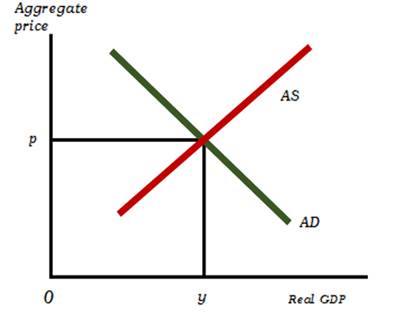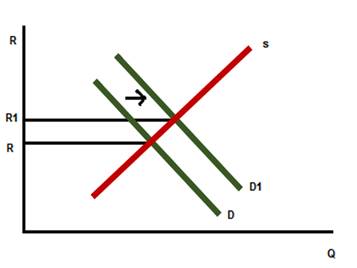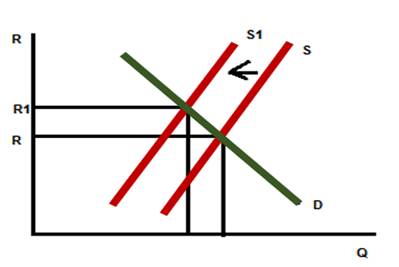
a)
A graph that shows aggregate demand,
a)
Explanation of Solution
The following graph shows aggregate demand and aggregate supply along with equilibrium in the economy.

In the graph, the horizontal axis represents the real GDP and the vertical axis shows the aggregate price level. Here, the aggregate demand curve slopes downward, and the
The balance between total supply and total demand is depicted on the graph. When there is no excess of total demand, the demand that supply cannot satisfy, and when there is no surplus supply of output for which there is no present demand,
Introduction: The set of economic factors such as price and quantity that operates the economy regularly is called equilibrium in the economy.
b)
How the decrease in taxes would affect AD, SRAS, LRAS, equilibrium aggregate price level, and output on graph
b)
Explanation of Solution
The following graph represents the impact of taxes on the AD, LRAS, and SRAS curves, and the

The decrease in tax shifts the demand to the right and the supply curve upward as there is an increase in the aggregate price level that in turn increase the demand and supply due to the cut of tax rates.
Introduction: The set of economic factors such as price and quantity that operates the economy regularly is called equilibrium in the economy.
c)
The graph of the market for loanable funds that show the effect of increased borrowing on the interest rate.
c)
Explanation of Solution
The following graph of the market for loanable funds shows the effect of increased borrowing on the interest rate.

In the graph, R is the interest rate which is shown on the vertical axis and Q is the quantity output which is represented by the horizontal axis.
When there is a decrease in tax rates, then the interest rates are increased. This happens because reductions in tax rates may encourage people to work, save, or invest anywhere but if they are not immediately offset by spending cutbacks, then, they will probably increase the federal budget deficit which in turn eventually causes the country's saving rate to fall and therefore, the interest rates go up.
Introduction: A global decentralized market for trading currencies is known as the foreign exchange market and for every currency, the foreign exchange rates are set by this market.
d)
The graph of the foreign exchange market that shows the effect of the change in the interest rate on the supply of U.S. dollars and how it (interest rate) affects the supply of U.S. dollars.
d)
Explanation of Solution
The following graph of the foreign exchange market shows the effect of the change in the interest rate on the supply of U.S. dollars:

In the graph, R is the interest rate which is shown on the vertical axis and Q is the quantity output which is represented by the horizontal axis.
The graph shows that the change in interest rates impacts the supply by decreasing it in the economy as the rise in interest rate moves the supply curve to the left. This happens because the increase in interest rates makes the currency less expensive in the market.
Introduction: A global decentralized market for trading currencies is known as the foreign exchange market and for every currency, the foreign exchange rates are set by this market.
e)
What happened to the value of the U.S. dollar and the effect on U.S. exports and aggregate demand?
e)
Explanation of Solution
According to the graph, in this case, aggregate demand would decrease because the increase in interest rate would decrease the value of the U.S. dollar in the market which affects the export in the country adversely. As it makes the export of goods expensive when there is an increase in interest rates which causes the value of currency down. Therefore, it in turn leads to a decrease in aggregate demand in the economy as it becomes expensive to purchase and consume goods in the country.
Introduction: A global decentralized market for trading currencies is known as the foreign exchange market and for every currency, the foreign exchange rates are set by this market.
Chapter 45 Solutions
Krugman's Economics For The Ap® Course

 Principles of Economics (12th Edition)EconomicsISBN:9780134078779Author:Karl E. Case, Ray C. Fair, Sharon E. OsterPublisher:PEARSON
Principles of Economics (12th Edition)EconomicsISBN:9780134078779Author:Karl E. Case, Ray C. Fair, Sharon E. OsterPublisher:PEARSON Engineering Economy (17th Edition)EconomicsISBN:9780134870069Author:William G. Sullivan, Elin M. Wicks, C. Patrick KoellingPublisher:PEARSON
Engineering Economy (17th Edition)EconomicsISBN:9780134870069Author:William G. Sullivan, Elin M. Wicks, C. Patrick KoellingPublisher:PEARSON Principles of Economics (MindTap Course List)EconomicsISBN:9781305585126Author:N. Gregory MankiwPublisher:Cengage Learning
Principles of Economics (MindTap Course List)EconomicsISBN:9781305585126Author:N. Gregory MankiwPublisher:Cengage Learning Managerial Economics: A Problem Solving ApproachEconomicsISBN:9781337106665Author:Luke M. Froeb, Brian T. McCann, Michael R. Ward, Mike ShorPublisher:Cengage Learning
Managerial Economics: A Problem Solving ApproachEconomicsISBN:9781337106665Author:Luke M. Froeb, Brian T. McCann, Michael R. Ward, Mike ShorPublisher:Cengage Learning Managerial Economics & Business Strategy (Mcgraw-...EconomicsISBN:9781259290619Author:Michael Baye, Jeff PrincePublisher:McGraw-Hill Education
Managerial Economics & Business Strategy (Mcgraw-...EconomicsISBN:9781259290619Author:Michael Baye, Jeff PrincePublisher:McGraw-Hill Education





